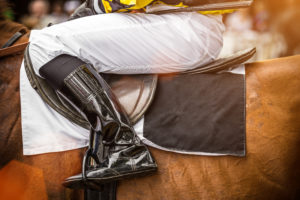
Appropriate stirrup placement is important for safety, balance, and correct riding skills. Many factors come into saddle fitting, such as riding discipline, pelvic tilt, seat bone width, and weight carriage, but have you considered your upper/lower leg ratio? A larger ratio may call for a readjustment of the stirrup bar to be placed farther back in the saddle.
When you get in the saddle, are your legs swinging? Are you bumping into the pommel when rising? Maybe your knee comes over the front of the flap, or maybe you keep losing a stirrup. You might want to measure your upper and lower leg to find if the stirrup bar is placed correctly for you.

One-Size-Does-NOT-Fit-All
For women, the angulation of the hipbone attachment is different than men’s. This makes a lady’s legs unable to fall straight down, as a male’s typically does.
Commonly, most women’s measurements from the top of the pelvis to the side of the knee is longer than the lower leg. A three-centimeter difference between the length of the top leg and bottom leg is normal for women that are 5’6” or shorter. The taller the woman, the greater the difference. This is why the long-legged will often buy a saddle that is too big for them. They buy a larger size to keep their knee on the flap, because the stirrup bar is usually placed too far forward for them.
 As the stirrup bar acts like a swing, gravity determines where the lower leg will go. If it is too far ahead of the rider’s hip, the lower leg will swing forward. This forces the weight and balance on the bar, as opposed to the seat. Placing your legs too far back, inevitably activates an unbalanced position, causing you to lean forward. This causes the horse to drop and slow or stop to try and catch their balance. Similarly, placing all of your weight on your seat bones cause you to become heavier. Adding this stress can cause your horse’s back to become tense.
As the stirrup bar acts like a swing, gravity determines where the lower leg will go. If it is too far ahead of the rider’s hip, the lower leg will swing forward. This forces the weight and balance on the bar, as opposed to the seat. Placing your legs too far back, inevitably activates an unbalanced position, causing you to lean forward. This causes the horse to drop and slow or stop to try and catch their balance. Similarly, placing all of your weight on your seat bones cause you to become heavier. Adding this stress can cause your horse’s back to become tense.

However, when a rider’s balanced weight is on the seat of the saddle, their balance comes from the core. Not the feet. When the rider’s weight does go into the stirrups the lower leg will swing to the stirrups leather’s resting position, with proper stirrup adjustment.
Riding, and the tack that comes along with it, is always different for each horse and rider. The feeling of a properly positioned saddle isn’t uncomfortable or out of balance. Also, you should not be fighting the position the saddle puts you in. As stirrup length and position is particular to whoever is in them, some people prefer to ride with shorter stirrups, and others with longer ones. As the American Quarter Horse Association Daily warns: As long as a rider is not using the stirrup as a foot rest, your hips are less likely to lock and your riding habits will be much safer.
Benefits of Proper Riding Position

When stirrups are the appropriate length, it’s much easier to keep your heels down and yourself down in the saddle. You sustain your anchor when your calf muscles are flexed, which maintains a leg-lock position. You improve your posture, the capability to get up on your seat bones, and your overall riding performance. Many riders also turn to pilates to further improve their posture.
Improper positioning or fit is important to fix, as it can lead to back pain in your horse. Lack of rider balance can also lead to this problem. The Horse reports that the signs of equine back pain include hollowing their back, inverting their neck, and attempting to avoid the rider. Optimum performance requires all aspects of the horse and rider to be in order.

Having an equal weight distribution of the rider’s two seat bones and pelvis — the three-point position — can help you communicate with your horse much more effectively. With correct saddling fit and positioning, you will feel the positivity that translates in your horse’s behavior and performance. Both you and your horse benefit from a properly fitted saddle, and you both deserve happy rides.

